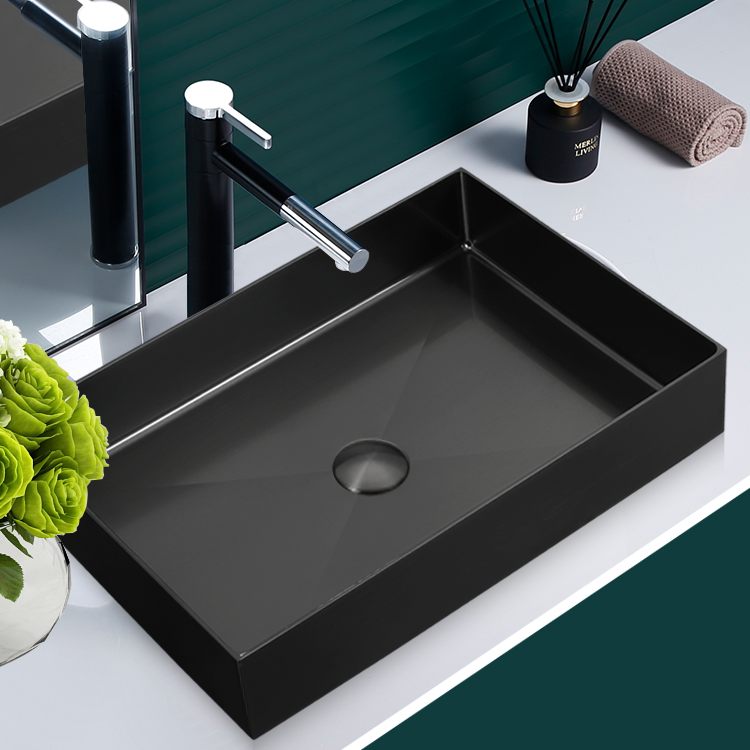מודרני כיורathroom סגנונות המגדירים פנים עכשווים
אביזרי שולחן תלויים: הצהרות פלסטיות בסגנון מינימלי
מוצרי אמבטיה מסוג 'vessel sinks' הם בחירה מושכת שמשתתפים גם כיצירות אמנות בתוך תכנון האמבטיה המינימליסטי. סinks נפרדים אלו משכרים את העין, מה Renders אותם ליצירה האמנותית של כל אמבטיה מודרנית. מכיוון שיש מגוון חומרים שבהם ניתן לייצר sinks מסוג vessel, יש גם אפשרות להמחיש את הבחירה. אדם יכול לבחור בפורצלן עבור מראה קלאסי או להשתמש בבקר עבור גישה מודרנית יותר, שניהם יוצרים washbasins מסוג vessel. אפשר להשתמש במתכות עבור מראה תעשייתי יותר, והבחירה תלויה בהעדפות ובדרישות הפרט. התעשייה הראתה דרישה חזקה למוצרי wash basins מסוג vessel. בשנת 2023, הם היוו כמעט 37% מסך שוק wash basins כולו. הפופולריות הגוברת היא כתוצאה מהתampilות הייחודית ומאפשרת מגוון רחב של בחירות, מה שמאפשר ללקוחות להתאים את האמבטיה שלהם לצרכיהם.
אביזרי אמבטיה מחוברים לקיר: מרביתת יעילות החלל
הפתרון האחר הוא אביזרי רחצה מונחים על הקיר, שהם את העיקרון המוחלט של שימוש יעיל בחלל ומכאן שclusão הם מתאימים ביותר לאמבטיות קטנות. מכיוון שהם תלויים על הקיר, הם פותחים חלל קרקע, מה שמעניק נותן לכל אמבטייה הרגשה של הרחבה. זה בדיוק הסיבה מדוע סוגים כאלה של אביזרי רחצה הפכו לפופולריים יותר במרחבים קטנים באופן כללי, כי אביזרי רחצה הם מטרים מרובים שאבדו, וכל מטר מרובע חשוב בצורה קריטית. עם זאת, המאה ה-21 ראתה את הגעתה של סינק שמשלבת תכונות נראות עם פונקציונליות: דגמים מציאותיים עתידיים, עיצובי קלאסיקה הם פונקציונליים ומקיימים את תפקידם בעיצוב בשני המקרים. השפעה זו גם ניתנת להסבר תיאורטית בהקשר לצמיחה התשוקה לנצל חללים קטנים, עם מחקרים בעיצוב פנים מצביעים על כך שהאנשים מעדיפים אמבטיות קטנות, מה שמעיד שהסינק צריך לעשות יותר עבודה בהתקנת האמבטיה.
מזרני תחתית: התמזגות חלקה לשורות נקיות
אחד הפופולריים ביותר בקרב בעלי בתים מודרניים, אביזרי סינק תחתון הם ידועים בשל הפוטנציאל המצוין שלהם ליצירת קווים חלקים ונקיים בכלathroom. בזכות הסגירות של הסינק, שאינן קיימות באפשרויות מסורתיות, מודלים תחתונים יכולים להשתלב בקלות עם כמעט כל חומר שולחן עבודה, כולל גרניט, מרמרא או קואرتץ. תכונה זו אינה רק מושכת מבחינה חזותית אלא גם מאוד מעשית מכיוון שהעדר קצוות נוספים מאפשר ניקוי פשוט יותר ללא תפיסת שאריות ופסולת. בהתחשב בכך שמשפחות מודרניות נמשכות לתשתי אמבטיה שמציגות שילוב אופטימלי בין עיצוב ופונקציונליות, אביזרי סינק תחתון מבקשים בצורה כבדה בקרב הקהל היעד. על פי נתוני דירוג כללי, אביזרי סינק תחתון מקבלים הערכות חיוביות מהצרכנים, בהינתן שהאחרונים מעריכים עיצוב חלק ואיכות
חדשנות חומרית כיורathroom עיצוב
סיום מט: עליית משטחים לא מזרזים
I. אביזרי שולחן לavage בסיימנים מתונים הפכו לפופולריים כיום. הם יוצרים תחושה של סיבוכיות מודרנית תוך כדי התעוררותה של אטמוספירה שקטה ומחממת. A. הסיבה להתפתחות זו קשורה במפלס החזר האור שלהם. B. התשוקה לשטחים מתונים זכתה בתמיכה כאשר הוספו אפשרויות מתאימות היטב. C. אף על פי שהחקר שלנו בתחום מדעי המאגרים מצא ששטחים מתונים אינם מחומלים כמו השטחים המבריקים בהיבט של נשיקה, הם מראים שאביי שולחן מתונים פחות נוטים להראות את חתימת האצבע והזיהום ממים מאשר השטחים המבריקים. D. בהתבסס על תוצאות אלו, תעשיית העיצוב הבינה שהעדפתם של אנשים למשטחים מתונים הייתה גבוהה יותר מהעדפות למשטחים מבריקים בשנים האחרונות.
אבן טבעית וคอนקרט: קבלת טקסטורות אורגניות
בימינו, אבן טבעית ובטון הם החומרים המועדפים ביותר מבחינת עיצוב כיור האמבטיה בשל המרקם הבלתי סדיר שלהם והתאמה מושלמת עם חיים יוקרתיים. המרכיב מעניק אחדות לטבע לחדרים אמבטיה, ובכך מספק תחושה דומה למרחב הטעם האורגני שהוא פופולרי מאוד במאה האחרונה. בין הסוגים הטיפוסיים ביותר ניתן לבחור גרניט ומרמר. למרות ששניהם יש להם כמה דמיון, הם יכולים להיות מוגדרים על ידי המאפיינים המיוחדים שלהם שאינם משתלמים מספיק. לגראניט יש תכונה ידועה של עמידות למים ולכתמים. חשוף לגורמים חיצוניים, גרניט מפרץ את המרקם שלו, יוצר מראה אלגנטי. לעומת זאת, הבורג מתקשר עם רמה גבוהה של אלגנטיות אשר מעלה אוטומטית את דירוג חדר האמבטיה לקטגוריה איכותית גבוהה יותר. אנשי מקצוע בתחום הנדל"ן גם מאשרים את העלייה בהוצאות של נכס עקב ההשקעה הפיננסית בחומרים טבעיים. זה מוכח גם על ידי המידע על 60% של גידול ביכולת של לקוח לקנות מוצר סיום אם הוא עשוי מחומר אורגני.
חומרים מורכבים: עמידות פוגשת אישית
חומרים חומריםposite מטילים את האופן שבו סinks אמבטיה נוצרים, מאיצים בין חופש יצירתי עם עמידות יוצאת דופן. תודות לחומרים חומרים כמו רזין, שהוא היסוד לרוב sinks אמבטיה, ואבן, סוג זה של sink הוא הרבה יותר עמיד ומסוגל יכול לעמוד בבחינת ההוצאות וההפסדים. כאשר sinksposite זוכים בתמיכת קהל גדלה ובשימוש בבתים ש trafic, אין ספק שהם ישתמרו על המראה והרכיבים שלהם לאורך זמן. sinksPOSITE מפורסמים בעיקר בזכות היכולת להתאים לצרכים של השאר הarea, מכיוון שהם באים בצבעים שונים וfinishes שיכולים להתאים לפי טעמים אישיים וסגנון personal style של בעל הבית. כיום, לקוחות לקוחות לקוחותanggan הולכים ומתגברים להפוך לcomposite כחומר לsinks אמבטיה, שצפוי צפויים לגדול בשל מספר bigger של לקוחות-customers שמעדיפים חומרים שיוכלו להחזיק זמן רב יותר ויותר personalization.
Лементים תיכוני Design של Sinks מודרניים
עומקים ארגונומיים של Basis לשימוש מעשי
עומק סinks ארגונומי הוא חיוני בעיצוב מודרני של אביזרי שטיפת ידיים כדי לשפר את נוחות המשתמש וההיבטים הרגילים. באמצעות חיבור עומקים ארגונומיים, יצרנים יכולים להבטיח שהמשתמשים יוכלו לבצע את משימותיהם היומיומיות בצורה נוחה ללא מאמץ יתר. למשל, ילדים ואנשים עם קשיי כפיפה יגנו יותר על ידי שימוש בסinks רדודים, בעוד שsinks עמוקים יספקו הגנה רבה יותר מפני התזוזות. בולט במיוחד ש- sinks המתיימרים לפי חוק זכויות האנשים לpersons עם מוגבלות מעוצבים במיוחד כדי לוודא שאנשים עם צרכים מיוחדים יוכלו להשתמש בהם. חוקרים הראו באופן תדיר שההוספה של עיצוב ארגונומי מותאם למשתמשים מוצדקת בהקשר של מגורים פרטיים. לכן, זה מצדיק את חשיבותם המובהקת לשיפור חווית השימוש וההיבטים הרגילים של אביזרי שטיפת ידיים.
מערכות ניקוז משולבות לאסתטיקה מאופנת
מערכות מערכות סינק אינטגרליות חדשניות מזיזות את התפיסה של אנשים על בית הכסא והמטבח שלהם. יחידות אלו אינטגרליות לתוך הסינק, מה שנותן להן מראה חלק יותר, מפחית רעש חזותי ומוסיף לסגנון הכללי שלathroom. ללא דרנות נראות ופתחים חשופים לדרנת, מערכות דרנת אינטגרלית מצליחות להשיג מראה נקי וחליק, שהוא מגמה צומחת בحمامים מודרניים. המגמה תואמת את דעת התעשייה שצוטטה בכך שהimers מפגינים העדפה לשימוש בחומרים פחות וליותרת.
דבר נוסף שהדוחות התעשיות האחרוניםديثים הודיעו עליו הוא שהצנזורה של תכנון הכיור זוכה בהכרה בקרב בעלי בתים ומעצבי פנים. בעוד שאנשים מנסים להשיג עיצוב פשוט ופונקציונלי, כיורים שניתן להכיל בהם דrainage הפכו לחלק חיוני מהעיצוב המודרני שלathroom פנים. הם לא רק מעלים את האסתטיקה של העיצוב של הכיור, אלא drainage מוסיף לפונקציונליות שלathroom על ידי ביטחון שהשטח תמיד נקי ונראה מסודר. בנוסף, הכיורים גם נעשים יותר אגראסנטיים ומינימליסטיים.
תכונות חכמות: טכנולוגיה ללא מגע במודלים עכשוויים
תכונות חכמות, כולל ברזים ללא מגע וחומרים משולבים, צברו פופולריות בדגםי כיורים מודרניים לרחובנות, ויצרו עידן חדש של אופן שבו אנשים שומרים על היגיינה או חוסכים מים. טכנולוגיית מגע-חופשית, תכונה המשולבת בדגמים מתקדמים יותר כגון [ ברז כיור חכם ללא מגע Luxice ], היא היגיינית יותר שכן היא מקטינה את הסיכויים לנגיעה במשטח potentially מזוהם. מעבר לחשיבה סביבתית, יצרנים דגשו את חשיבות הבטחה של אובדן מים מזערי או ללא אובדן בכלל, בהתחשב בכך שמים הם נושא סביבתי חשוב. במקרה הזה, ברזים חסרי מגע חוסכים מים בצורה יעילה, ומאפשרים הפחתה משמעותית בצריכת המים עקב הפופולריות הגוברת שלהם, ומשמשים דרישה גבוהה מצד הצרכנים לתכונות חיסויי מים, כפי שניכר מגידול בפער טכנולוגיות חיסויי מים מחקר conducted לאחרונה.
הטנדים מהבוחרים הטכנולוגיים מצביעים על כך שכולל טכנולוגיה חכמה במכשיריathroom יהיה נפוץ אפילו יותר, מספק תקלה ונקיות כמו גם תאימות עם מערכות הבית החכמות האחרות. ממצאים כאלה גורמים לפיתוח סביבת הבית החכם בה פעולות רבות מתבצעות אוטומטית ויותר אנשים יכולים להתאים את מה שאתה רוצה שהבית שלך יעשה בשבילך. המעבר לטכנולוגיה חכמה משנה את מה שאנחנו מצפים לו ומגביה את התקן עבור תצורותathroom העתידיות שתכלולเทคโนโลยיה כדי להכין את החיים יותר נוחים והכי יעיל.
מקרני Bathroom כנקודות מוקד בעיצוב מרחב
Urniture צפה עם אינטגרציה של מקרן
כיור רחצה צף הפך במהרה לאחד המאפיינים הפופולריים ביותר בחדרי אמבטיה מודרניים, ובצדק - הוא נראה נהדר, והסגנון מציע כמה יתרונות ברורים. הרמה מהקרקע תיצור תחושת מרחב - דבר שלעתים קרובות חסר בחדרי אמבטיה קטנים יותר. מעצבים משיגים את המראה הנהדר הזה על ידי חיבור הכיורים למשטח הכיור, כך שלא נוצר רווח מסוכן ביניהם שבו אתם עלולים לאבד פריטים קטנים לתוך מערכת הצנרת. על פי מחקרי שוק, הביקוש הצרכני לעיצובים של כיורים צפים נמצא במגמת עלייה, מה שמדגיש את המעבר שלו למיינסטרים עבור חתך רחב של צרכנים.
טכנiques של גיוון צבעי לimpact חזותי
מקרני אמבטיה והשימוש בקונטרסט צבעים קונטרסט צבעים טוב תמיד הוא שיטה מוצלחת להשתמש בה, מכיוון שהוא יכול לגרום לבת הכי שלך להיראות חדשה ושונה בעיניך. צבעים יכולים להיות המנפץ מצב רוח בבית, כיוון שהם עוזרים לך ליצור אטמוספרה נעימה, מזמנת וחיונית. צבעים משלימים, כבדים וקלים, יכולים ליצור קונטרסט מושך, הדגשה פרטים של עיצוב ויצירת 'אפקט מאיר'. דעות מומחים ומחקרים גם מתארים דוגמאות מוצלחות שבהן הקונטרסט של צבעים חידש את הסביבה של האמבטיה, מראים שהשיטות האלה הן מפתח לשיפור עיצוב מרחב ותperience של המשתמש!

צורות גאומטריות.setLayoutManagers קומפקטיים
מקרני שYYY עם צורות גיאומטריות יוצרים את האפשרות של שימוש יעיל יותר בחלל. באמצעות קווים נקיים וצורות לא רגילות, תבניות בעיצוב גיאומטרי מציעות פונקציונליות שמשתמשת בחלל בצורה יעילה. למשל, היא מציעה שימוש קל ופשוט והופעה מודרנית שמציינת לקוחות ללקוחות שחיפשו גםpearance וpracticality עבור אורח החיים שלהם. מגמות מראות שהצורות הגיאומטריות הן על ההעלאה בעיצוב חדרי כושר, אומרים מומחי עיצוב, כי הם מובילים לחללים שהם מושכים כמו שהם מעשיים. גישה כזאת עוזרת ליצור עולם מאוזן ומחוסן מבחינה אסתטית שמתאים בצורה מושלמת לצרכים של התגוררות קומפקטית של ימינו.
בהוספה של איברי תכנון חלליים אלו עם טכנולוגיות מודרניות כמו שפכים ללא מגע או מנגנוני סנסורים מובנים, יכולים בעלי בתים להשיג בו-זמנית אתגר بصבי ותפקוד משופר, מה שמציג את השינוי בהעדפות הצרכן לעיצובי בית שימושיים.
מגמות עולות בפתרונות א_sink__Custom לרחצה
מקרנות מותאמות אישית להצהרות אדריכליות ייחודיות
כיור מותג לפי בקשת הלקוח הוא הטרנד המסחרי החדש ביותר, כאשר בעלי בתים רוצים ליצור הצהרות עיצוב שמחזירות את טעמם האישי. כיורים מותגים מציעים אופציות כמעט בלתי מוגבלות כשמדובר בהדפסה ובהפיכת השירותית שלך למרחב שייחד שלך. suche קיורים מותגים יכולים להיבנות בצורה, גודל או חומר כמעט כלשהו כדי להתאים למושג האדריכלי של אדם. כמה מרקמים - כמו Kohler ו-Toto - רואים עלייה בביקוש לשירותי עיצוב מותגים שמציעים את האפשרות להדפיס הכל, מהסיום של הברז ועד החומר של הקיר. SUCH דרגה גבוהה של הדפסה אינה רק עבור פרויקטים גדולים ומוכרת יותר ויותר מכיוון שאנשים אוהבים להחזיק בשליטה מלאה על ההחלטיות העיצוב שלהם.
צירופי חומרים מעורבים בעיצובי מותרות
הרכבת חומרים שונים מתחדשת את המראה היקר של אביזרי שטיחת אמבטיה - מוסיפה עניין חזותי וקונטרסט טקスтури. מעצבים יכולים ליצור אביזרים שמצרפים בין צבעים תוך כדי קיום דרישות הביצועים על ידי שילוב חומרים כמו שיש, זכוכית ומתכת. הרעיון זה הוביל להמצאות חדשניות ובנוסף לפיתוחים בעיצוב האמבטיה והפונקציונליות שלה. שימוש กรอบ מתכתי עם קערהbuat שיש מספק קונטרסט מרגש של סגנון תעשייתי וחן טבעי של קערת השיש שנוצרה באופן טבעי. שילוב חומרים הוא תואם לדרישה הגוברת של מוצרים לאמבטיה שמשלבים ביצועים גבוהים ומראה יקר ורך בו זמנית.
עיצוב sinks התואם למרחבים רב-תכליתיים
עם מגוון של פונקציות ועוצבים, סinks של ימינו נחשבים חלק מהORNAMENTציה של המטבח והحمام, ולא רק כהבעת טעם אלא גם כתצוגה של תכנון החלל. סinks אלו מציעים חופש להתערבב, לערבב ולהתמזג עם ערכות חمام כדי ליצור תחושת פתוח או מרחב חופשי בכל חمام בבית. למשל, סinks עם גבהים מתאימים או סוגי מודולריים יכולים לענות על ההעדפות של מגוון משתמשים, כולל משפחות עם ילדים או אינדיבידואלים עם מגבלות גופניות. הגדרת תצורות מותאמת היא תכונה מושכת עבור בעלי בתים היום - מאפשרת להם לקבל שילוב של סגנון ופונקציונליות מעשית. בנוסף, מקורות תעשייתיים מצביעים על כך שהעיצובים הניתנים לשינוי עצמם גדלים בעוצמה, שוב מוכיחים את חשיבותם של עיצובים מזינים בעיצוב הפנים המודרני.



